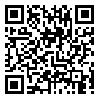Volume 17, Issue 7 (9-2017)
Modares Mechanical Engineering 2017, 17(7): 353-362 |
Back to browse issues page
Download citation:
BibTeX | RIS | EndNote | Medlars | ProCite | Reference Manager | RefWorks
Send citation to:



BibTeX | RIS | EndNote | Medlars | ProCite | Reference Manager | RefWorks
Send citation to:
Salighe S, Mohammadi H. Designing virtual vibration absorber with adaptable stiffness for vibrations control under harmonic excitation with noise in time-varying frequency. Modares Mechanical Engineering 2017; 17 (7) :353-362
URL: http://mme.modares.ac.ir/article-15-8552-en.html
URL: http://mme.modares.ac.ir/article-15-8552-en.html
Abstract: (4706 Views)
In the present article, a real mass-spring system under external excitation with time-varying frequency is studied. The external excitation causes additional oscillations in the real mass-spring system response which disrupt the path tracking procedure. Adaptive control law, which is considered for annihilating the additional oscillations, is equal to a virtual vibration absorber which its stiffness regardless of the real system and external excitation uncertainties, can be updated based on the linear absorber theory until the natural frequency of the absorber reaches the excitation frequency. The variation of the frequency is based on the step and ramp function which relatively are equal to the sudden and transient change from the initial value to the final value of the frequency. Besides, the effects of the noise with various amplitudes existed in the transient variation of the frequency on updating the virtual absorber stiffness is developed. Simulation results are presented to demonstrate that the determined adaptation law guarantees the adaptation of virtual absorber stiffness considering excitation frequency variation based on both step function and ramp function and eliminates additional vibrations of the real system.
Article Type: Research Article |
Subject:
Control
Received: 2017/01/24 | Accepted: 2017/06/3 | Published: 2017/08/4
Received: 2017/01/24 | Accepted: 2017/06/3 | Published: 2017/08/4
| Rights and permissions | |
 |
This work is licensed under a Creative Commons Attribution-NonCommercial 4.0 International License. |







